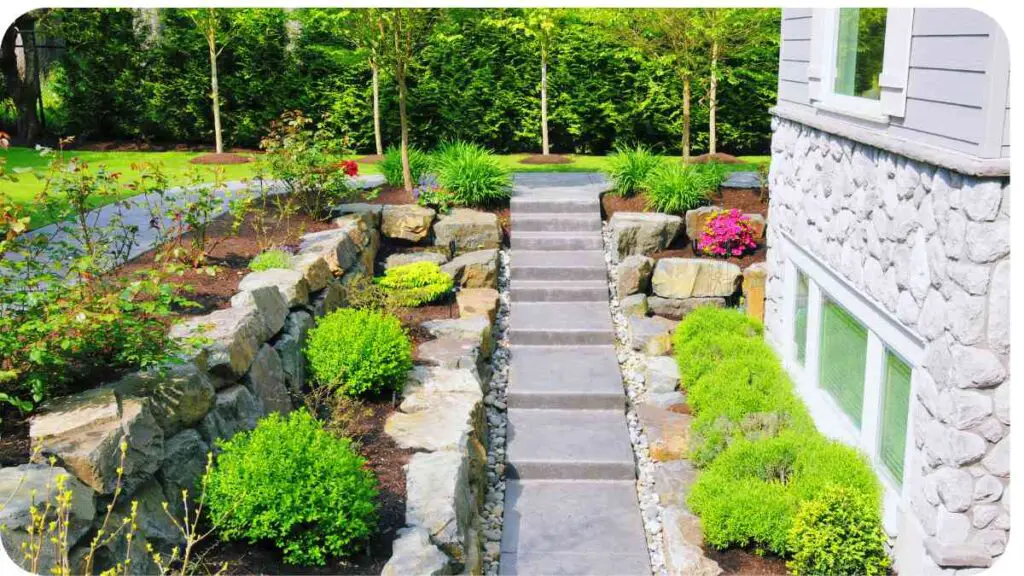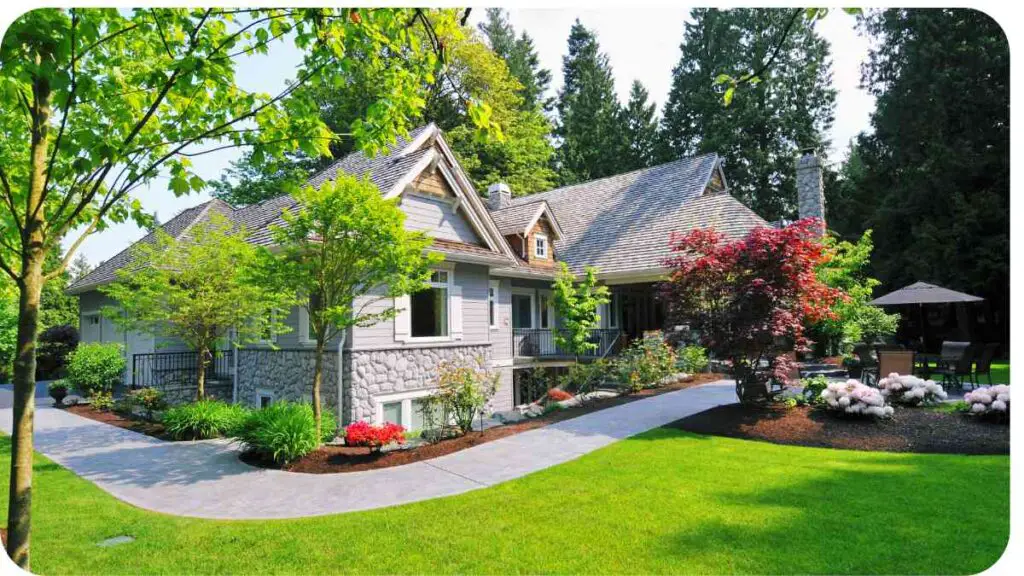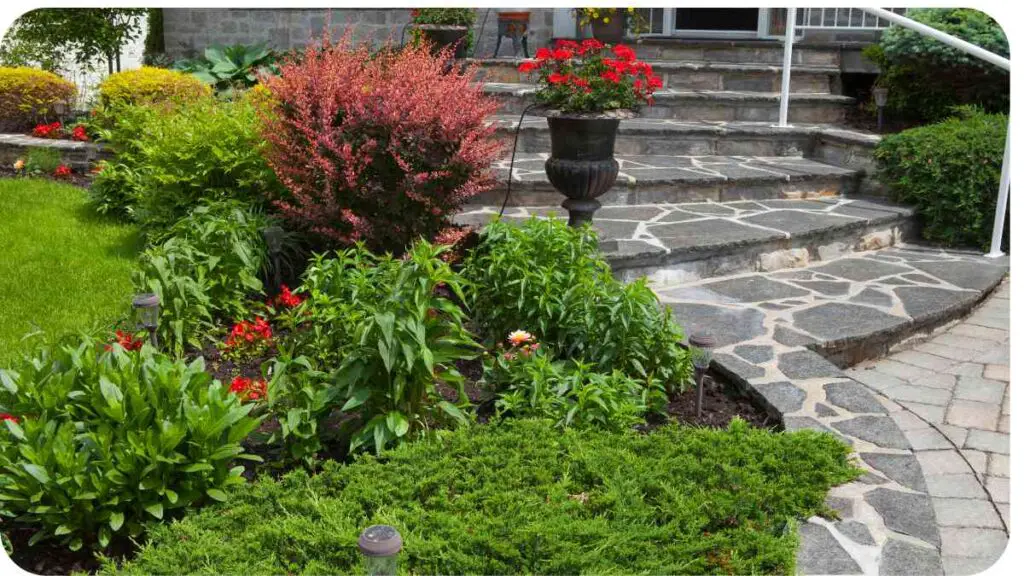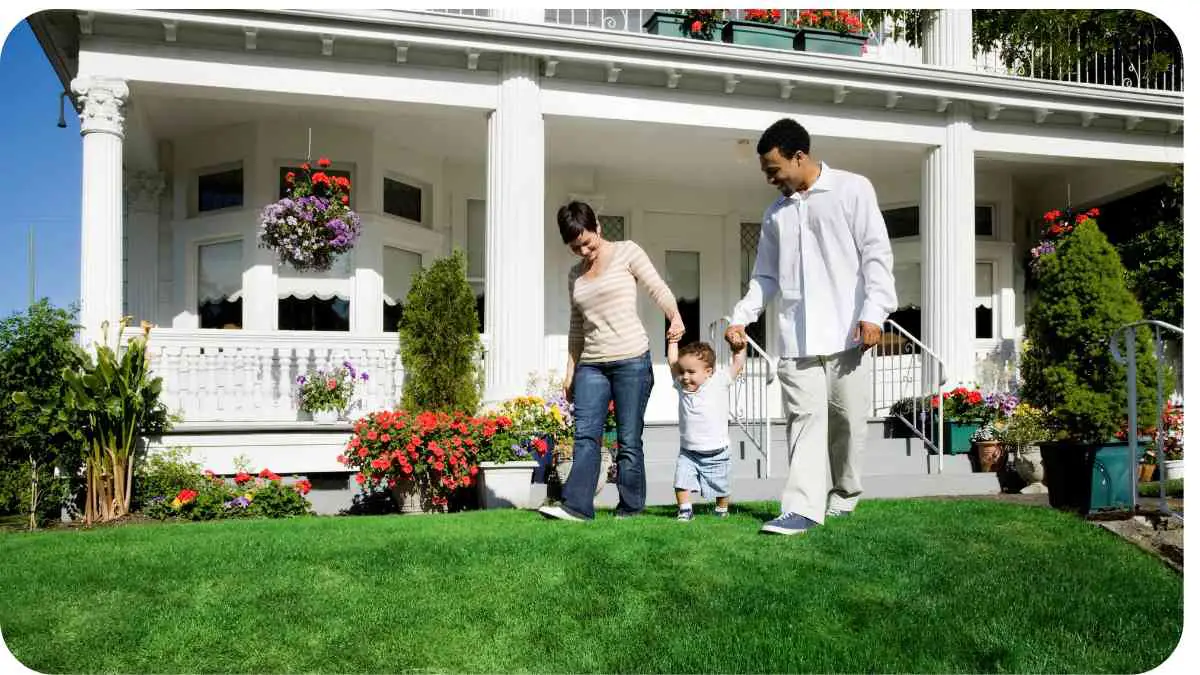Your front yard is the first impression visitors have of your home, so why not make it stunning? Designing a beautiful front yard doesn’t have to be daunting. Whether you’re starting from scratch or giving your existing landscape a facelift, this guide will walk you through the process of designing a front yard that wows.
| Takeaways |
|---|
| 1. Assess your current front yard to understand its features and needs. |
| 2. Set clear goals for your landscaping project, focusing on aesthetics and functionality. |
| 3. Create a detailed design plan, including planting beds, focal points, pathways, and outdoor features. |
| 4. Choose plants and materials carefully, considering climate, maintenance, and visual appeal. |
| 5. Implement your design thoughtfully, following proper planting and hardscape installation techniques. |
| 6. Incorporate hardscape features and personal touches to enhance the overall design. |
| 7. Illuminate your front yard effectively with strategically placed lighting fixtures. |
| 8. Maintain your front yard regularly to keep it healthy and attractive throughout the year. |
| 9. Budget wisely by determining your priorities and getting multiple quotes if hiring professionals. |
| 10. Decide whether to tackle the project yourself or hire a professional based on your skills and budget. |
| 11. Avoid common landscaping mistakes like neglecting planning and overcrowding plants. |
| 12. Embrace sustainable practices to reduce environmental impact and maintenance needs. |
| 13. Enhance curb appeal through tidy maintenance and thoughtful design choices. |
| 14. Enjoy the process of designing and creating a front yard that reflects your personal style and preferences. |
2. Assessing Your Front Yard

Before diving into design ideas, it’s essential to assess your current front yard. Use the checklist below to evaluate what you have and what you want to change.
Transform your sloping front yard into a beautiful landscape with these creative ideas. Landscape a Sloping Front Yard offers practical solutions to overcome the challenges of a sloping yard.
Table: Front Yard Assessment Checklist
| Aspect | Evaluation |
|---|---|
| Existing Plants | Identify what plants are currently in your front yard. |
| Soil Quality | Test soil pH and drainage. |
| Sunlight Exposure | Note areas of full sun, partial shade, and full shade. |
| Existing Features | Assess the condition of pathways, driveways, etc. |
| Views and Privacy | Consider what views you want to enhance or screen. |
| Problem Areas | Identify areas prone to erosion, flooding, or poor drainage. |
Assessing these aspects will help you understand your front yard better and guide your design decisions.
3. Setting Goals for Your Front Yard
Now that you’ve assessed your front yard, it’s time to set some goals for your landscaping project. What do you want to achieve with your front yard design? Think about both aesthetics and functionality.
Are you aiming for a low-maintenance landscape? Do you want to increase curb appeal? Or perhaps creating a welcoming space for relaxation and entertainment is your priority?
Setting clear goals will help you stay focused during the design process and ensure you end up with a front yard that meets your needs and desires.
Maximize the potential of your front yard with these creative ideas for outdoor enjoyment. Maximizing Your Front Yard provides inspiration and guidance for homeowners looking to enhance their outdoor spaces.
4. Creating a Design Plan
With your goals in mind, it’s time to create a design plan for your front yard. A well-thought-out plan will serve as a roadmap for your landscaping project.
Table: Sample Front Yard Design Plan
| Element | Description |
|---|---|
| Planting Beds | Decide on the location and shape of planting beds. |
| Focal Points | Choose focal points such as trees, shrubs, or sculptures. |
| Pathways | Plan pathways for accessibility and visual interest. |
| Lawn Area | Determine the size and shape of the lawn area (if any). |
| Outdoor Features | Include features like seating areas, water features, or fire pits. |
| Color Scheme | Select a color scheme for plants and materials. |
Mapping out these elements will help you visualize how your front yard will look and function once completed.
5. Choosing Plants and Materials
Selecting the right plants and materials is crucial for creating a beautiful and cohesive front yard landscape. Consider factors such as climate, maintenance requirements, and aesthetic appeal when making your choices.
Table: Recommended Plants for Front Yard Landscaping
| Plant Name | Sunlight Requirements | Watering Needs | Height at Maturity | Special Features |
|---|---|---|---|---|
| Lavender | Full sun | Low | 1-3 feet | Fragrant blooms, drought tolerant |
| Boxwood | Full sun to partial shade | Moderate | 3-6 feet | Evergreen, formal appearance |
| Daylilies | Full sun to partial shade | Low | 1-4 feet | Colorful blooms, low maintenance |
| Japanese Maple | Partial shade to full shade | Moderate | 10-25 feet | Ornamental foliage, fall color |
| Ornamental Grasses | Full sun to partial shade | Low | 1-6 feet | Texture and movement in the landscape |
Choose a variety of plants that offer visual interest throughout the seasons and complement your design style.
Table: Common Front Yard Landscaping Materials
| Material | Description |
|---|---|
| Mulch | Helps retain moisture, suppress weeds, and improve soil health. |
| Gravel | Low-maintenance option for pathways and decorative areas. |
| Pavers | Versatile option for pathways, driveways, and patios. |
| Natural Stone | Adds a rustic and timeless look to hardscape features. |
| Wood | Suitable for fencing, decking, and garden edging. |
Consider how these materials will enhance the overall look of your front yard and complement your home’s architecture.
Save water and create a beautiful landscape with these tips for designing a xeriscape front yard. What is a Xeriscape Front Yard? provides a comprehensive guide to creating a water-efficient landscape
Choosing Wisely
When selecting plants, opt for a mix of perennials, shrubs, and trees that thrive in your local climate. Similarly, choose materials that not only look good but also suit your maintenance preferences and budget.
6. Implementing Your Design
Now that you have a solid plan and have chosen your plants and materials, it’s time to put your design into action. Here are some steps to follow during implementation:
- Prepare the Site: Clear the area of any existing vegetation, rocks, or debris. Prepare the soil as needed by adding amendments or leveling the ground.
- Planting: Start by planting larger trees and shrubs first, then fill in with smaller plants. Follow planting instructions carefully, ensuring proper spacing and depth.
- Install Hardscape Features: Lay pathways, patios, or other hardscape elements according to your design plan. Proper installation is crucial for durability and aesthetics.
- Add Mulch or Ground Cover: Apply mulch around plants to conserve moisture, suppress weeds, and improve soil health. Consider using ground cover plants for added visual interest.
- Watering and Initial Care: Water newly planted vegetation thoroughly and regularly until established. Follow care guidelines for hardscape features as well.
Understanding the amount of sun your front yard gets is essential for successful landscaping. How Much Sun Does My Front Yard Get? offers practical tips for assessing your yard’s sun exposure.
7. Adding Hardscape Features
Hardscape features not only add functionality but also contribute to the overall aesthetics of your front yard. Here are some popular options to consider:
Table: Popular Hardscape Features for Front Yards
| Feature | Description |
|---|---|
| Pathways | Create paths using materials like gravel, pavers, or natural stone. |
| Driveway Borders | Define driveway edges with bricks, pavers, or plants for a polished look. |
| Patio or Deck | Create an outdoor living space for relaxation and entertainment. |
| Retaining Walls | Terracing or retaining walls can add dimension to your landscape. |
| Water Features | Fountains or ponds add a soothing element and attract wildlife. |
Incorporate hardscape features that complement your home’s style and meet your practical needs.
Personal Touch
Consider adding personal touches such as unique sculptures, custom-made gates, or handmade pottery to make your front yard truly special and reflective of your personality.
8. Incorporating Lighting
Don’t overlook the importance of lighting in your front yard design. Proper lighting not only enhances the beauty of your landscape but also adds safety and security. Here’s how to incorporate lighting effectively:
Table: Types of Lighting Fixtures for Front Yard
| Fixture | Description |
|---|---|
| Path Lights | Illuminate pathways and guide visitors safely to your door. |
| Spotlights | Highlight focal points such as trees, sculptures, or architectural features. |
| Uplights | Shine light upward to accentuate trees or architectural elements. |
| Wall Sconces | Provide ambient lighting and add a decorative touch to walls or entryways. |
| Deck Lights | Illuminate decks or patios for evening enjoyment. |
Strategically placed lighting can create depth and drama in your front yard while increasing visibility after dark.
Lighting Tips
- Layer Your Lighting: Combine ambient, task, and accent lighting for a well-lit and inviting space.
- Use LED Lights: Opt for energy-efficient LED fixtures to save on energy costs and reduce maintenance.
- Install Timers or Sensors: Consider timers or motion sensors to automate your outdoor lighting for added convenience and security.
Add color and beauty to your front yard with these tips for building flower beds. How to Build a Front Yard of Flower Beds provides guidance and inspiration for creating stunning flower beds.
9. Maintenance Tips for a Beautiful Front Yard

Maintaining your front yard is essential to keep it looking its best year-round. Here are some maintenance tasks to incorporate into your routine:
Table: Seasonal Front Yard Maintenance Checklist
| Season | Maintenance Tasks |
|---|---|
| Spring | – Prune shrubs and trees<br>- Weed planting beds<br>- Mulch renewal |
| Summer | – Water plants regularly<br>- Deadhead flowers<br>- Fertilize as needed |
| Fall | – Rake leaves<br>- Clean gutters<br>- Plant bulbs for spring blooms |
| Winter | – Protect sensitive plants from frost<br>- Remove snow from pathways<br>- Check outdoor lighting |
Regular maintenance ensures your front yard stays healthy and attractive throughout the year.
Pro Tip
Consider creating a calendar or schedule to remind you of seasonal maintenance tasks, making it easier to stay on top of caring for your front yard.
10. Budgeting for Front Yard Landscaping
Budgeting is an essential aspect of any landscaping project. Knowing how much you’re willing to spend will guide your design choices and help you prioritize where to allocate your funds. Here’s how to budget effectively:
- Determine Your Budget: Decide how much you’re comfortable spending on your front yard project. Consider factors like materials, labor costs, and any additional features you want to include.
- Get Multiple Quotes: If you’re hiring professionals for certain aspects of the project, such as hardscape installation or tree planting, obtain quotes from several contractors to compare prices.
- Allocate Funds Wisely: Prioritize your spending based on what’s most important to you. Allocate more budget to elements that have the most significant impact on your goals.
- Plan for Contingencies: It’s wise to set aside a portion of your budget for unexpected expenses or changes to the project scope.
11. DIY vs. Hiring a Professional
Deciding whether to tackle your front yard landscaping as a DIY project or hire a professional depends on various factors:
- DIY:
- Pros: Cost-effective, allows you to have full control over the project, can be a rewarding experience.
- Cons: Time-consuming, requires knowledge and skills, may lack professional finish.
- Hiring a Professional:
- Pros: Expertise and experience, saves time and effort, ensures professional results.
- Cons: Higher cost, less personal involvement in the process.
Consider your budget, time availability, and skill level when making this decision.
12. Front Yard Landscaping Mistakes to Avoid

Avoiding common pitfalls can save you time, money, and frustration in your front yard landscaping project. Here are some mistakes to steer clear of:
- Neglecting Proper Planning: Rushing into the project without a clear plan can lead to design flaws and wasted resources.
- Overcrowding Plants: Planting too many plants too close together can lead to overcrowding as they mature, requiring more maintenance and causing competition for resources.
- Ignoring Maintenance Needs: Choosing high-maintenance plants or features that you’re unwilling to care for can result in a neglected landscape.
- Forgetting Scale and Proportion: Ensure that elements in your front yard are proportionate to the size of your house and yard to maintain visual balance.
13. Sustainability in Front Yard Design
Creating a sustainable front yard not only benefits the environment but also reduces maintenance and water usage. Here are some sustainable practices to consider:
- Choose Native Plants: Native plants are adapted to the local climate and require less water and maintenance once established.
- Water-Wise Landscaping: Incorporate drip irrigation, rain barrels, and drought-tolerant plants to reduce water consumption.
- Permeable Surfaces: Use permeable paving materials to allow rainwater to infiltrate the soil and reduce runoff.
- Compost and Mulch: Use compost to improve soil health and mulch to retain moisture and suppress weeds.
14. Enhancing Curb Appeal
Curb appeal adds value to your home and makes it more inviting. Here are some tips to enhance your front yard’s curb appeal:
- Keep it Tidy: Regularly mow the lawn, trim edges, and remove weeds to maintain a neat appearance.
- Add Color: Plant colorful flowers or use colorful containers to add pops of color to your front yard.
- Upgrade the Entryway: Enhance your entry with a well-maintained pathway, a stylish front door, and attractive lighting fixtures.
- Maintain Trees and Shrubs: Keep trees and shrubs pruned and healthy to frame your home beautifully.
15. Conclusion
Designing a landscaping front yard can be both exciting and rewarding. By following these steps and tips, you can create a front yard that not only enhances the beauty of your home but also reflects your personal style and meets your practical needs. Remember, it’s not just about how your front yard looks, but also how it makes you feel every time you come home. Happy landscaping!
Further Reading
For those looking to dive deeper into front yard landscaping, here are some additional resources:
- Lowes: Front Yard Landscaping Ideas
Discover a variety of landscaping ideas and tips to enhance your front yard’s appeal. - Better Homes & Gardens: Planning Your Front Yard Landscape
This guide offers practical advice on planning and designing your front yard landscape. - Garden Design: Front Yard Landscaping
Explore creative and inspiring front yard landscaping designs and ideas.
FAQs
What are the first steps in designing a front yard landscape?
Start by assessing your front yard’s current conditions, including space, sunlight, and soil quality. This will help you understand what plants and features will work best in your yard.
How do I choose the right plants for my front yard?
Select plants that are suitable for your climate and soil conditions. Native plants are often a great choice because they are well-adapted to the local environment and require less maintenance.
What is the importance of creating a focal point in front yard landscaping?
A focal point draws the eye and creates a sense of order and interest in your yard. This can be achieved with elements like a striking tree, a water feature, or a beautiful garden ornament.
How can I make my front yard landscaping more sustainable?
Incorporate native plants, use water-saving techniques such as drip irrigation and mulching, and consider implementing rainwater harvesting systems to make your landscaping more eco-friendly.
When should I consider hiring a professional landscaper?
Consider hiring a professional for complex installations, large-scale designs, or when you need specialized knowledge to achieve the best results. A professional can bring expertise and efficiency to your project.

Hi! My name is Hellen James, and I’m here to help you with your home-maintenance needs. Whether it’s building a better yard or just trying to fix a garden—I can show you how.


